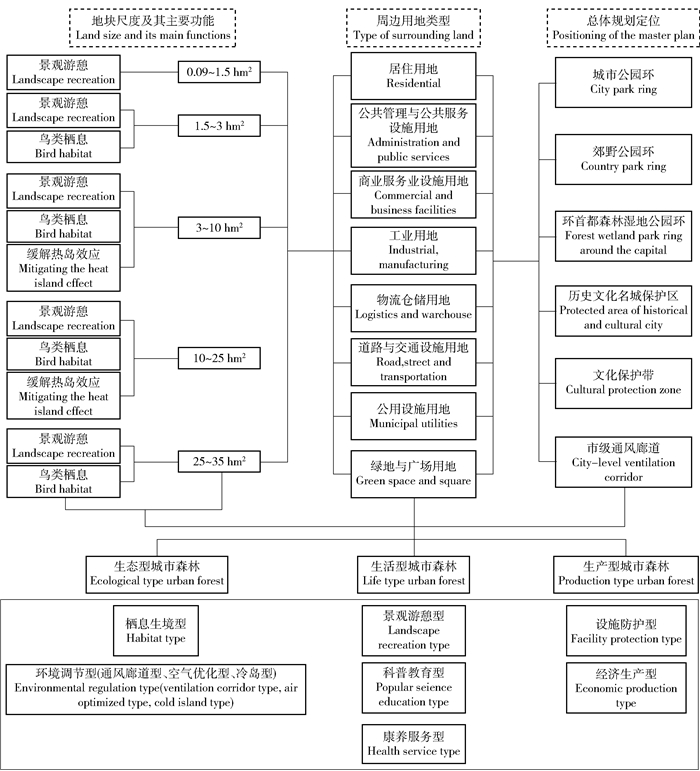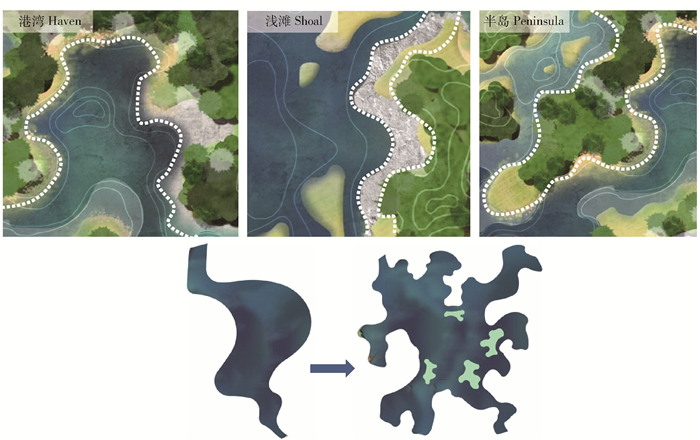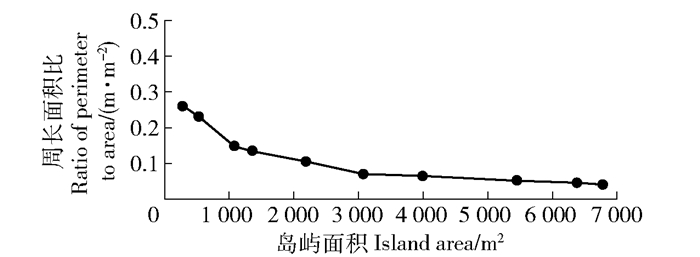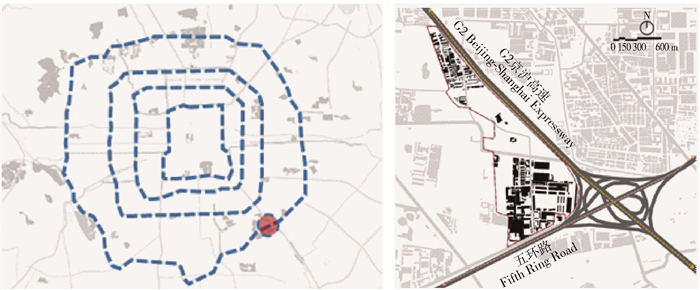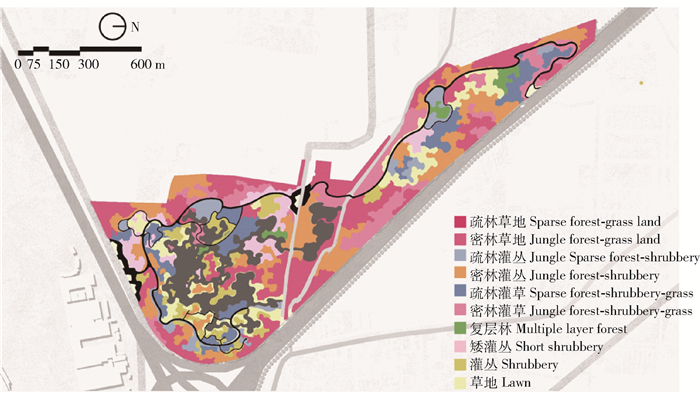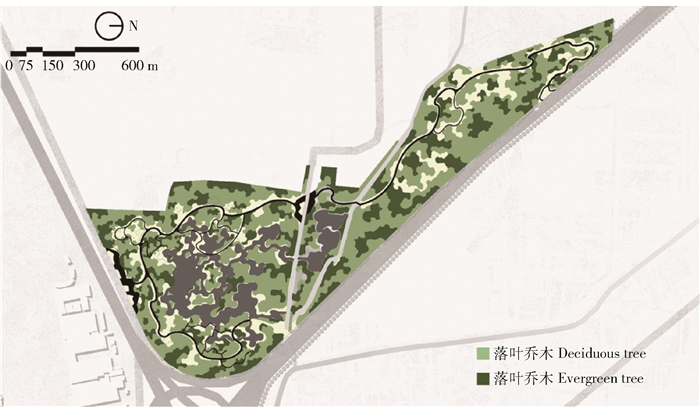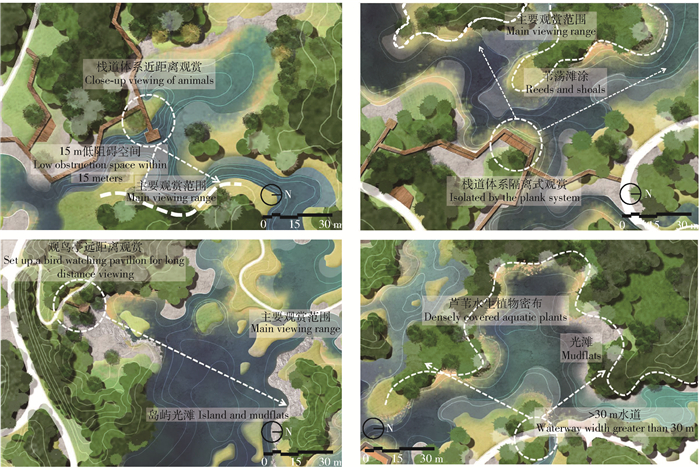Research on habitat-type urban forest construction strategy in Beijing in the background of "leave blank space and increase green space"
-
摘要:目的《北京城市总体规划(2016年—2035年)》提出“留白增绿”,让森林进入城市。城市森林具有多种功能,是城市生态系统的重要组成部分。本研究旨在探索城市森林功能类型及栖息生境型城市森林营建策略,以期实现特定城市背景下城市森林功能的拓展,使城市森林成为解决不同城市问题的绿色空间,促进城市生态系统的可持续发展。方法本文在对大量文献进行研究的基础上,依据不同尺度城市森林所能发挥的主导功能、周边用地类型、城市总体规划定位三大因素对城市森林功能类型进行论述,并对栖息生境型城市森林营建策略进行研究。结果提出生态型、生活型、生产型3个一级分类,包括栖息生境型、环境调节型、景观游憩型、科普教育型、康养服务型、设施防护型、经济生产型共7个二级分类。城市化进程造成了城市生物多样性锐减,重视和保护生物多样性成为城市发展的重要环节。本研究选择以提高生物多样性为主要目标的栖息生境型城市森林为研究对象,提出目标物种选择、林地生境、水体生境营建策略,并以横街子城市森林为例,对营建策略进行实践。结论对城市森林功能类型进行论述,能够为城市森林营建提供目标指引。对栖息生境型城市森林进行营建策略研究可以为未来城市森林建设提供参考依据。Abstract:ObjectiveBeijing Urban Master Plan (2016-2035) puts forward the goal of "leave blank space and increase green space" and let forest enter the city. Urban forest has multiple functions and is an important part of urban ecosystems. The purpose of this study is to explore the functional types of urban forest and the strategies for habitat-based urban forest construction, with a view to realize the expansion of urban forest functions in a specific city context, making urban forest as a green space for solving different urban problems, and promoting the sustainable development of urban ecosystems.MethodIn this context, based on the study of a large number of literatures, this study discusses the function types of urban forest based on the three main factors: the dominant function, the type of surrounding land, and the positioning of the master plan, and research on habitat-based urban forest construction strategies.ResultThree primary categories of ecological type, life type and production type were proposed, including seven secondary classifications of habitat type, environmental regulation type, landscape recreation type, popular science education type, health service type, facility protection type and economic production type. Urbanization has led to a sharp decline in urban biodiversity, paying attention to and protecting biodiversity has become an important part of urban development. This study selected habitat-based urban forest with the main goal of improving biodiversity as the research object, proposed the construction strategy of target species selection, woodland habitat and water habitat, and took the Hengjiezi urban forest as an example to practice the construction strategies.ConclusionThe discussion of urban forest function types can provide target guidance for urban forest construction. The research on construction strategy of habitat type urban forest can provide reference for future urban forest construction.
-
塑−木插接节点是一种塑料与木材插接连接的节点形式,此节点通常位于塑料椅的坐面与椅腿连接部位及靠背的装配接合处等,这些位置都是关键的受力点,如若配合参数设计不佳在使用过程中则容易出现松动、变形及断裂等现象,从而降低产品的使用寿命[1-3]。目前关于家具结构节点的研究仍然以木家具的榫卯节点为主,其研究方向主要为对影响节点强度的设计参数的优化[4-7],对提高速生材节点强度的新型接合方式的探索[8]以及对人工板材家具构件的连接方式与接合强度的研究等[9-10]。本次研究对影响节点强度的不同参数组合的节点试件分别进行抗拔强度与抗弯强度试验,并通过响应面法对试验数据进行回归分析,从而得到塑−木插接节点的配合特性和最优的配合参数,为塑料家具插接结构设计提供方法和数据参考。
1. 材料与方法
1.1 材料与设备
本研究的试验材料为:聚丙烯(PP),生产厂商为台湾李长荣化工,型号为(福聚)/7012;榉木(Fagus sylvatica),购于本地木材市场,含水率为11.91% ~ 12.03%,气干密度为0.689 ~ 0.710 g/m3[11]。主要试验设备为:海天塑机HTF110X;原力WPC数控机床,加工精度为0.01 mm;日本岛津AG-X万能力学试验机及相关夹具;精密推台锯、横截锯等。试验选择在温度20 ℃、相对湿度50%的恒温恒湿的室内环境下进行。
1.2 试件的制备
榉木试件的制作:首先选取无缺陷榉木原料,使用推台锯与横截锯将其开成截面为40 mm × 40 mm,长度为140 mm的长方形试件坯料,通过刨切加工使其表面平整光滑,然后使用数控机床按照图1a所示的样式和参数将其一头加工成圆棒,存放于干燥环境中备用。PP塑料试件的制作:首先使用Creo软件按照图1b所示结构与尺寸进行三维建模,将建好后的模型交给模具厂进行开模,待模具制作完成后通过注塑成型获得试件。试件的装配:按照图1c所示装配方式,使用木槌对各组试件进行装配,将装配好的试件放置在恒温恒湿环境中一周后进行试验。
1.3 试验方法
本研究主要考察塑−木插接节点的配合参数对其接合强度的影响。根据Box-Behnken试验设计原理,在其他设计条件都一定的情况下,选取塑料件壁厚t、接合长度d和过盈配合量f为考察因素,以节点构件的抗拔强度与抗弯强度为响应目标,进行3因素3水平的响应面分析,利用Design-Expert软件对数据进行回归分析,建立数学模型,预测节点构件最佳力学性能状态下的配合参数。通过预组装单因素测试,接合长度的取值范围为30 ~ 50 mm,单边过盈配合量在0.05 ~ 0.15 mm。根据塑料件成型工艺原理,PP材料较大型构件的合理壁厚范围为2.4 ~ 3.2 mm[12],由此确定各因子水平(表1)。
表 1 试验因子水平设置Table 1. Experiment factor levels因素 Factor 水平 Level − 1 0 1 壁厚 Wall thickness of plastic parts (t)/mm 2.4 2.8 3.2 接合长度 Inserting length (d)/mm 30 40 50 配合量 Interference fit (f)/mm 0.05 0.10 0.15 由于该节点的接合强度分别表现为抗拔强度与抗弯强度,因此需要将每组试件分成两批,分别进行抗拔性能与抗弯性能试验。
1.3.1 塑−木插接节点的抗拔性能测试
将试件按照如图2所示方法固定在力学试验机上,以0.05 mm/s的速率垂直向上加载,将榉木榫头从塑料接口中匀速拔出,行程达到10 mm时停止试验,获得其最大抗拔力。以上试验共15组,每组重复6次,共计90个试件。
1.3.2 塑−木插接节点的抗弯性能测试
将试件按照如图3所示方法固定在力学试验机上进行弯曲破坏试验,通过加载端以0.05 mm/s的速率匀速向下加载,在测得弯曲载荷经过最大值并开始出现减小趋势时停止试验,获得其最大弯曲破坏载荷。试验组与试验次数安排与抗拔性能试验相同。
1.3.3 不同装配方式节点的抗拔性能对比测试
由于节点的配合形式对接合强度有显著的影响,为了能够进一步提高塑−木插接节点的接合强度,因此在以上研究的基础上分别对以下3种不同配合形式节点进行了抗拔性能的对比分析:选择以0.15 mm的过盈配合量进行装配(Ⅰ型节点);采用在配合间隙为0的接合面涂白胶装配(Ⅱ型节点);采用在配合间隙为0的接合面法向安装GB/T 950-86-M2 × 20木螺钉(Ⅲ型节点)。试件尺寸和装配如图1,其中塑料件壁厚2.4 mm、接合长度50 mm。采用图2所示的方法进行试验,测得各个类型节点的最大抗拔力,并对节点的破坏形式和抗拔力进行对比分析。试验共3组,每组重复6次,共计18个试件。
2. 结果与分析
根据表1所示的水平与因素对试件分批进行抗拔性能与抗弯性能试验,试验结果见表2。将试验结果输入design-expert软件进行响应面回归分析,获得相应的拟合编码方程式(1)和式(2),其中Y1表示极限抗拔力,Y2表示极限弯曲载荷,由方程得到的预测值如表2所示。
表 2 响应面分析试验设计及结果Table 2. Experiment design and results of response surface method试验号
No.塑料件壁厚
Wall thickness of plastic
parts (t)/mm接合长度
Inserting length (d)/mm配合量
Interference fit (f)/mm抗拔力
Withdrawal force/N弯曲载荷
Bending load/N试验值
Experiment value预测值
Prediction value试验值
Experiment value预测值
Prediction value1 0 0 0 765.7 846.0 1 046.1 1 066.0 2 0 0 0 851.2 846.0 1 065.7 1 066.0 3 0 − 1 − 1 186.6 214.0 743.6 757.8 4 0 1 − 1 445.0 419.0 1 213.2 1 221.7 5 0 − 1 1 1 075.1 1 101.2 829.8 821.3 6 1 − 1 0 447.5 459.1 874.6 868.6 7 1 1 0 992.6 1 057.6 1 305.9 1 305.6 8 0 1 1 1 677.8 1 650.5 1 211.9 1 197.7 9 − 1 0 1 629.8 668.7 935.6 943.8 10 0 0 0 921.1 846.0 1 086.3 1 066.0 11 1 0 − 1 258.9 220.0 1 138.2 1 130.0 12 − 1 1 0 237.2 225.6 1 076.7 1 082.7 13 1 0 1 1 826.5 1 788.9 1 110.6 1 125.1 14 − 1 − 1 0 134.8 69.8 679.2 679.5 15 − 1 0 − 1 81.3 118.9 914.0 899.5 Y1=846.0+305.3t+188.57d+529.68f+110.68td+254.78tf+86.08df−269.99t2−122.99d2+123.11f2 (1) Y2=1066.03+102.97t+210.06d+9.86f+8.45td−12.3tf−21.87df−28.48t2−53.45d2−12.95f2 (2) 2.1 塑−木插接节点的配合特性分析
该节点是通过榉木构件与塑料构件插接装配而成,在实际使用中构件之间不能够产生松动或晃动,否则会造成节点力学性能的失效,因此构件之间必须采用过盈配合的方式装配才能保证节点接合强度,其配合量则是影响强度大小的关键因素。一般来说,选择较大的过盈配合量可以获得更好的接合强度,但过大的过盈配合量又可能导致装配困难或塑料构件的损伤,因此需要控制在合适的范围内。经组装测试得出该节点试件的过盈配合量在0.15 mm以内较为合适。
本次研究中的塑料构件采用了注射成型,受工艺的限制,构件接口的内壁与脱模方向会存在一定的脱模角度。在本次试验中将脱模角假设为0°,而实际试件为0.5°,因此这会给节点试件的配合量造成一定的误差,从而影响到整体的接合强度。研究表明:随着接合长度的增加,试验得出的抗拔力比理论值略微偏大,但对抗弯强度没有影响。接合面的粗糙度同样会对节点的抗拔强度产生影响,然而由于脱模角度不宜设计过大,因此塑料件的内壁必须设计成光滑面,否则会造成脱模困难。
2.2 构件强度对节点接合强度的影响
节点的强度是建立在构件的强度之上的,若要获得较好的节点整体强度,首先必须保证构件自身的强度。在试验过程中,塑料构件的破坏程度明显大于榉木构件,说明其强度要远低于榉木构件,由此可见,塑料件的强度会对节点的整体接合强度产生决定性的影响。
通过design-expert软件单因素分析可以获得在插接长度为40 mm,过盈配合量为0.1 mm的条件下塑料件壁厚对节点接合强度的影响结果(图4),其中构件的力学强度主要表现为塑料件壁厚,壁厚越大,强度越高。由图4可见节点的抗拔力和弯曲载荷都随着塑料构件壁厚的增加而增加。当塑料件壁厚由2.4 mm增大为2.8 mm时,节点的抗拔力增加较为显著,其主要是由于较薄的塑料件壁厚会产生较大的弹性变形,从而降低了节点接合面的摩擦力所致;当塑料件壁厚由2.8 mm增大为3.2 mm时,节点的抗拔力增加较小,这说明通过增加壁厚来提高节点的抗拔力有一定的限制。同时,节点的弯曲载荷随着塑料件壁厚的增加呈线性增加趋势,这说明增加壁厚可以有效改善构件的抗弯强度,然而由于成型工艺的限制塑料构件的壁厚不能无限制的增加,因此其力学强度不能够仅通过增加壁厚的方式来改善。在实际应用中其他的一些结构强化方式可以综合采用来增强塑料构件的强度,然而这对本次研究的结果并不会产生影响。
2.3 塑−木插接节点配合参数优化
2.3.1 塑−木插接节点抗拔性能分析
在抗拔试验中,试件的破坏特征不明显,外观无明显的痕迹。对试验后的塑料试件测量后发现接口尺寸略微增大,重新装配后进行抗拔试验,发现节点的抗拔力有不同程度的减小。这说明塑料构件在装配过程中已经发生了塑性变形,多次装配会导致节点强度的部分失效。
表3是对抗拔试验结果进行的方差分析,结果显示塑料件壁厚、接合长度和过盈配合量的P值都小于0.05,说明这3个设计因素对节点的抗拔强度都有显著影响。模型的F值为75.34,P < 0.000 1,说明建立的模型是显著的,试验结果中不会产生突变量,这种试验方法是可靠的。决定系数R2为0.992 7,信噪比为27.391,说明拟合方程式(1)有较高的拟合度与可靠性,可以用来对塑−木插接节点的抗拔强度进行预测。本次试验中变异系数值(10.95%)较高,说明试验的精确度有所欠缺,这很有可能是受到塑料构件接口处脱模角度的影响,因为脱模角度会导致过盈配合量的误差产生。
表 3 抗拔强度方差分析Table 3. ANOVA of tensile strength方差来源 Variance source 平方和 Sum of squares df 均方 Mean square F P 显著性 Significance 模型 Model 4.006 × 106 9 4.451 × 105 75.34 < 0.000 1 *** 塑料件壁厚 Wall thickness of plastic parts (t) 7.457 × 105 1 7.457 × 105 126.21 < 0.000 1 *** 接合长度 Inserting length (d) 2.845 × 105 1 2.845 × 105 48.15 0.001 0 ** 配合量 Interference fit (f) 2.244 × 106 1 2.244 × 106 379.88 < 0.000 1 *** td 48 995.82 1 48 995.82 8.29 0.034 6 ** tf 2.596 × 105 1 2.596 × 105 43.95 0.001 2 ** df 29 635.62 1 29 635.62 5.02 0.075 2 — t2 2.691 × 105 1 2.691 × 105 45.55 0.001 1 ** d2 55 849.57 1 55 849.57 9.45 0.027 6 ** f2 55 963.15 1 55 963.15 9.47 0.027 5 ** 残差 Residual 29 541.45 5 5 908.29 失拟项 Lack of fit 17 426.31 3 5 808.77 0.96 0.546 9 纯误差 Pure error 12 115.14 2 6 057.57 总和 Cor total 4.036 × 106 14 注:拟合度 = 0.992 7;校正拟合度 = 0.979 5;预测拟合度 = 0.924 2;信噪比 = 27.391;变异系数 = 10.95%。“***”表示非常显著;“**”表示显著;“—”表示不显著。Notes: R2 = 0.992 7; Adj R2 = 0.979 5; Pred R2 = 0.924 2; Adeq precision = 27.391; C.V. = 10.95%. “***” means very significant; “**” means significant; “—” means non-significant. 图5为各个设计因素对节点抗拔力共同作用的响应面模型。由图5a可见:当塑料件壁厚较小时,接合长度对抗拔力的影响不大,而随着壁厚的增加,接合长度对抗拔力的影响增大;壁厚在2.4 ~ 2.8 mm之间时,曲面较为陡峭,抗拔力增长趋势明显;当壁厚在2.8 ~ 3.2 mm之间时,曲面趋于平坦,抗拔力增长趋势放缓。由图5b同理可得:当塑料件壁厚较大时,过盈量对抗拔力的影响更为显著。当过盈量较大时,壁厚对抗拔力的影响也更为显著。通过分析发现:这个现象是由于塑料构件本身的弹性引起的,随着壁厚的增加,塑料件的弹性会相应减小;同样配合量的条件下,壁厚大的节点构件接触面上的压力更大,而接触面的压力越大,其摩擦力也越大,节点的抗拔力也就越大。因此节点为了能够获得较好的力学性能,塑料件壁厚参数应该尽可能地设计大一些。
2.3.2 塑−木插接节点抗弯性能分析
在抗弯试验中节点的破坏形式如图6所示,其主要表现为由于应力集中而导致的塑性变形发白及断裂。图6是壁厚相同而榫头长度不同的构件节点的破坏特征,主要表现为:30 mm榫头长度的试件破坏特征是接口下方严重的发白变形,说明此处在试验中产生了过大的应力;40 mm榫头长度的试件破坏特征依然发生在接口下方,但同时在接口的上方出现了一道塑性变形发白,说明在试验中应力得到了分散,节点的抗弯强度得到了提高;50 mm榫头长度的试件在接口下方仅出现微小的变形发白,而且塑料件还发生了断裂现象,断裂处有明显的发白变形,说明试验中塑料件的上部产生较大的应力,这时候节点的强度主要表现为塑料构件的强度。由此可见,随着接合长度的增加,试验过程中构件产生的应力集中问题可以得到改善;在参数优化过程中,当节点的抗弯强度受到构件强度限制时,首先应该考虑的是提高塑料构件的强度。
表4是对抗弯试验结果进行的方差分析,结果显示:塑料件壁厚与接合长度的P值小于0.05,而过盈配合量的P值为0.220 6,大于0.05,说明抗弯强度受塑料件壁厚与接合长度这两因素的影响显著,不受过盈配合量的影响。模型的F值为127.02,P < 0.000 1,说明建立的模型是显著的,试验结果中不会产生突变量,这种试验方法是可靠的。决定系数R2为0.995 6,信噪比为38.462,说明拟合方程式(2)有较高的拟合度与可靠性,可以用来对塑−木插接节点的抗弯强度进行预测。本次试验中变异系数值为1.96%,远小于10%,说明试验的精确度很高,试验结果真实可靠。
表 4 抗弯强度方差分析Table 4. ANOVA of bending strength方差来源 Variance source 平方和 Sum of squares df 均方 Mean square F P 显著性 Significance 模型 Model 4.544 × 105 9 50 485.3 127.02 < 0.000 1 *** 塑料件壁厚 Wall thickness of plastic parts (t) 84 830.8 1 84 830.8 213.44 < 0.000 1 *** 接合长度 Inserting length (d) 3.53 × 105 1 3.53 × 105 888.19 < 0.000 1 *** 配合量 Interference fit (f) 778.15 1 778.15 1.96 0.220 6 — td 285.61 1 285.61 0.72 0.435 3 — tf 605.16 1 605.16 1.52 0.272 1 — df 1 914.06 1 1 914.06 4.82 0.079 6 — t2 2 994.69 1 2 994.69 7.53 0.040 6 ** d2 10 550.21 1 10 550.21 26.54 0.003 6 ** f2 619.61 1 619.61 1.56 0.267 1 — 残差 Residual 1 987.23 5 397.45 失拟项 Lack of fit 1 179.05 3 393.02 0.97 0.543 0 纯误差 Pure error 808.19 2 404.09 总和 Cor total 1.564 × 105 14 注:拟合度 = 0.995 6;校正拟合度 = 0.987 8;预测拟合度 = 0.954 7;信噪比 = 38.462;变异系数 = 1.96%。“***”表示非常显著;“**”表示显著;“—”表示不显著。Notes: R2 = 0.995 6; Adj R2 = 0.987 8; Pred R2 = 0.954 7; Adeq precision = 38.462; C.V.= 1.96%. “***” means very significant; “**” means significant; “—” means non-significant. 图7为各个设计因素对节点弯曲载荷共同作用的响应面模型。由图7a可见:在不同的塑料件壁厚与接合长度下,弯曲载荷都出现了单调性的增长。这说明塑料件壁厚与接合长度都对节点抗弯强度有影响,但不产生交互影响。由图7b可见:塑料件壁厚一定时,配合量的变化不会引起弯曲载荷的改变。这说明塑料件壁厚对节点抗弯强度没有影响。对比两幅图可以发现:接合长度引起弯曲载荷的变化最为明显,塑料件壁厚的影响稍弱。因此增加接合长度是提高节点抗弯强度最有效的方法。
2.3.3 配合参数的优化与验证
在对试验结果进行响应面分析的基础上,通过design-expert软件的优化模块对各个设计因素进行优化。首先定义各因子在设计域内,设定抗拔力与弯曲载荷目标值高于试验最大值两倍以上,然后对模型进行优化求解,得到优化结果(表5)。为了判断优化方案的准确性和有效性,接下来还需要通过物理试验对优化结果进行验证。将试验设计中各因素的中间水平设为初始值,优化求解结果设为优化值,接着分别制作试件进行抗拔强度和抗弯强度试验,最终试验结果如表5所示。试验结果显示:初始参数下节点的极限抗拔力为846.0 N,优化后提高到2 139.3 N,改进率为152.9%,预测值为2 051.2 N,与试验值非常接近;初始参数下的极限弯曲载荷为1 066.1 N,优化后提高到1 306.4 N,改进率为22.5%,预测值为1 268.3 N,同样与试验值非常接近。由此可以证明该优化过程和优化方案是准确可靠的。
表 5 优化方案与结果Table 5. Schemes and results of optimization项目 Item 配合参数 Matching parameter/mm 抗拔力
Withdrawal force/N弯曲载荷
Bending load/N塑料件壁厚
Wall thickness of
plastic part (t)/mm接合长度
Inserting length (d)/mm配合量
Interference fit (f)/mm初始值 Initial value 2.8 40 0.10 846.0 1 066.1 优化预测值 Prediction value of optimization 3.2 50 0.15 2 051.2 1 268.3 优化试验值 Experiment value of optimization 3.2 50 0.15 2 139.3 1 306.4 2.4 试验结果对比分析
对3种不同装配类型的塑−木插接节点进行抗拔试验,试验结果如图8所示,平均抗拔力大小依次为:Ⅰ型节点996.5 N < Ⅱ型节点1 251.4 N < Ⅲ型节点1 607.6 N。对比可以得知:Ⅱ型节点的平均抗拔力比Ⅰ型节点大了25.6%,约为254.9 N;Ⅲ型节点的平均抗拔力比Ⅰ型节点大了61.3%,约为611.1 N;Ⅲ型节点的平均抗拔力比Ⅱ型节点大了28.4%,约为356.2 N。这说明接合面涂胶和安装木螺丝的装配方式都能够提高塑−木插接节点的抗拔力,而安装木螺丝比接合面涂胶的效果更明显。
图9为不同类型节点在抗拔试验中的破坏形式。Ⅰ型节点主要表现为榫头从塑料构件接口中拔出,外观无其他明显破坏痕迹,由于塑料件的弹性,节点构件在进行重新组装后能够很大程度上恢复节点的力学性能。Ⅱ型节点主要表现为胶层与塑料件接合面的脱离,由于胶水对木材具有渗透性,木材表面的胶层剥离强度要远大于塑料,因此塑料件接合面胶层的更易发生剥离。Ⅲ型节点主要表现为木螺丝的歪曲变形并致使构件挤压破损,拉伸载荷使得在安装木螺丝的部位产生了应力集中,从而导致构件的局部破坏,如若增加木螺丝数量则可以有效地分担应力,进一步增加节点的抗拔强度。
3. 结论与讨论
本研究在不同配合参数的塑−木插接节点的力学试验基础上,对试验结果进行了响应面分析,并通过拟合方程获得了各个参数的最优解。试验证明优化方案比初始方案节点的力学性能有了明显的改善,这说明响应面方法可以用来解决多个因变量的结构节点中配合参数的优化设计问题,从而为家具结构设计提供了理论指导和数据参考。方差分析表明:塑料件壁厚t、接合长度d和过盈配合量f这3个设计因素均对节点的抗拔强度有显著影响,而抗弯强度只受塑料件壁厚与接合长度这两个因素的影响,与过盈配合量无关。优化结果显示:节点的极限抗拔力从846.0 N提高到2 139.3 N,改进率为152.9%,极限弯曲载荷从1 066.1 N提高到1 306.4 N,改进率为22.5%。通过分析可以发现:各设计参数在设计域内靠近上限取值较易获得最大接合强度,而节点的抗弯强度改进率相对较低,是由于受到塑料构件强度的限制。对比试验结果表明:在节点的接合面法向安装木螺丝能够有效地提高节点的抗拔强度。
本研究是从配合参数优化的方向尝试改善塑−木插接节点的力学性能,但影响结构节点强度的因素还有很多,并且各因素之间是相互联系且共同作用的。关于该节点力学性能的研究还可以从以下几个方面展开:不同材料因素对节点强度产生的影响;塑料构件接合面的脱模角度和接合面的粗糙度对节点强度的影响等。此外,近年来计算机辅助工程(CAE)技术越来越广泛地被用来解决各种工程结构的优化问题[13],不少学者正在尝试将其运用到家具结构的优化设计中来,这也是后续值得进一步探索的研究方向。
致谢: 本文是基于研究生风景园林课程设计成果所做的进一步研究,对共同参与课程设计的小组成员王美琳、皇甫苏婧、王宇泓、牛思亚表示感谢。 -
表 1 不同郁闭度二级生境类型
Table 1 Secondary habitat types with different canopy closure
一级类型
Primary classification二级类型
Secondary classification说明
Description乔木林
Tree forest疏林草地
Sparse forest-grass land无灌木或灌木覆盖度小于15%,乔木覆盖度在30%~70%之间
The shrub-free or shrub coverage is less than 15%, and the tree coverage is between 30% and 70%密林草地
Jungle forest-grass land无灌木或者灌木覆盖度小于15%,乔木覆盖度在70%~90%之间
The shrub-free or shrub coverage is less than 15%, and the tree coverage is between 70% and 90%疏林灌丛
Sparse forest-shrubbery灌木覆盖度在30%~70%之间,乔木覆盖度在30%~70%之间
Shrub coverage is between 30% and 70%, and the tree coverage is between 30% and 70%密林灌丛
Jungle forest-shrubbery灌木覆盖度在30%~70%之间,乔木覆盖度在70%~90%之间
Shrub coverage is between 30% and 70%, and the tree coverage is between 70% and 90%疏林灌草地
Sparse forest-shrubbery-grass land灌木覆盖度在15%~30%之间,乔木覆盖度在30%~70%之间
Shrub coverage is between 15% and 30%,and the tree coverage is between 30% and 70%密林灌草地
Jungle forest-shrubbery-grass land灌木覆盖度在15%~30%之间,乔木覆盖度在70%~90%之间
Shrub coverage is between 15% and 30%, and the tree coverage is between 70% and 90%复层林
Multiple layer forest灌木覆盖度大于15%,乔木覆盖度大于30%
Shrub coverage is more than 15% and tree coverage is more than 30%灌丛
Shrubbery矮灌丛
Short shrubbery灌丛高度小于1 m,灌木覆盖度大于30%,乔木覆盖度小于30%
Shrub height is less than 1 m, coverage is more than 30%, and tree coverage is less than 30%灌丛
Shrubbery灌丛高度大于1 m,独干灌木高度小于1.5 m,灌木覆盖度大于30%,乔木覆盖度小于30%
The shrub higher than 1 m, the height of branch independent plant is less than 1.5 m, the shrub coverage is more than 30%, and the tree coverage is less than 30%草地Lawn 草地
Lawn以草本植物为主,木本植物覆盖度小于15%
Mainly herbaceous, woody plant coverage is less than 15%表 2 林地鸟类生境营造
Table 2 Woodland bird habitat construction conditions
林地类型
Forest land type鸟的种类
Species of birds生境需求
Habitat requirement针叶林
Coniferous forest金翅雀Carduelis sinica、斑鸫Turdus eunomus 保证上层林木有一定盖度且生境下层较开敞, 草本植物丰富[49]
Ensure that the upper trees have a certain degree of coverage and the lower layer of the habitat is open with rich herbs[49]红嘴蓝鹊Urocissa erythroryncha 连续常绿林面积至少4 hm2[31]
Continuous evergreen forest area is of at least 4 ha[31]阔叶林
Broadleaved forest habitat燕雀Fringilla montifringilla 拾取草籽为食,喜上层乔木主干清晰,下层灌木稀疏的群落[47]
Picking up grass seeds for food, like the environment with clear branches of upper trees and lower sparse shrub community[47]白头鹎Pycnonotus sinensis、丝光椋鸟Sturnus sericeus 喜主干清晰下层开阔的阔叶乔木群落,灌木下层稀疏的植物或体量小的球形灌木[49]。距地面大多2~3 m筑巢,亦有筑在6~6.5 m高大乔木上[30]
Like the environment with clear branches and broadleaved trees, lower sparse shrub community or small spherical shrub[49]. Nesting on places 2-3 m higher than the ground, and nesting on 6-6.5 m tall trees[30]四声杜鹃Cuculus micropterus、大杜鹃Cuculus canorus 喜乔木主干通直,下层相对开阔,以阔叶林为主。搭配树龄较长的针叶树。喜既不影响飞行又能覆盖地表的丰富小灌木及草本空间[47]
Like trees with straight trunk, the lower layer is relatively open, mainly broadleaved forest. Pair with longer-aged conifers. Like rich shrubs and herbaceous spaces cover the surface but do not affect flight activities[47]黄眉柳莺Phylloscopus inornatus 喜株型挺拔整齐的高大乔木, 偏好落叶林和常绿林,如落叶密林草地和常绿密林灌丛草地[31]
Like straight and neat trees, preference deciduous forest and evergreen forest, such as deciduous jungle grassland and evergreen jungle shrub grassland[31]灌丛Shrub 黄喉鹀Emberiza elegans、红喉姬鹟Ficedula parva、褐柳莺Phylloscopus fuscatus 喜中等灌木和低矮的自然地被[30],常活动在林缘以及溪流沿岸的疏林与灌丛[48]
Like medium shrubs and low herbs[30], of ten active in forests and shrubs along the forest margins and streamlined[48]表 3 水体鸟类生境营造
Table 3 Aquatic habitat construction conditions
类别
Category科
Family种
Species生境需求
Habitat requirement水鸟
Water birds鹭科
Ardeidae大白鹭
Ardea alba喜在近水域或水中岛屿高树上营巢[49]。水域内需沉水、挺水植物覆盖率40%~60%之间,高于1 m的植物占60%左右,木本植物、挺水植物4 m以内越高越好。陆地植物7 m内越高越适宜[30]
Like to nest on high trees in the water or on the island[49].The coverage of aquatic plants in the waters is between 40% and 60%, plants above 1 m is about 60%. Woody plants and aquatic plants should be within 4 m and plants on land should within 7 m, the higher, the better [30]水鸟
Water birds鹭科
Ardeidae草鹭
Ardea purpurea喜栖息在水边灌丛或芦苇(Phragmites communis)沼泽[49]。水域内需沉水、挺水植物覆盖率40%~60%之间,高于1 m的植物占60%左右,木本植物、挺水植物4 m以内越高越好。陆地植物7 m内越高越适宜[30]
Like to inhabit in the shrubs or the reeds.The coverage of aquatic plants in the waters is between 40% and 60%, plants above 1m is about 60%. Woody plants and aquatic plants should be within 4 m and plants on land should within 7 m, the higher, the better [30]水鸟
Water birds鹭科
Ardeidae苍鹭
Ardea cinerea喜栖息于有大片芦苇和水生植物的浅水域[49]。水域内需沉水、挺水植物覆盖率40%~60%之间,高于1 m的植物占60%左右,木本植物、挺水植物4 m以内越高越好。陆地植物7 m内越高越适宜[30]
Like to inhabit in shallow waters with large reeds and aquatic plants.The coverage of aquatic plants in the waters is between 40% and 60%, plants above 1 m is about 60%. Woody plants and aquatic plants should be within 4m and plants on land should within 7 m, the higher, the better [30]水鸟
Water birds鸭科
Anatidae黑水鸡
Gallinula chloropus栖息于富有树木、芦苇和水生挺水植物遮蔽的淡水水域,不喜欢很开阔的场所[49]。栖息地水域植被覆盖率50%~75%为宜,其中30%~50%灌木,40%~70%挺水植物,0%~10%乔木,以及25%水面,水深0.9 m以内水域中宜有倒伏树干[30]
Inhabit in freshwater covered with trees, reeds and aquatic plants, do not like very open space[49]. The vegetation coverage 50%-75%, with 30%-50% shrubs, 40%-70% aquatic plants, 0%-10% trees, and 25% water surface. There should be fallen tree trunks in the water within 0.9 m[30]水鸟
Water birds鸭科
Anatidae鸳鸯
Aix galericulata喜在水深不超过2 m的浅水区觅食,水域植被覆盖率50%~75%为宜,近水区域结合少量乔灌,以木本上层结构为主[30]
Like to eat in shallow waters with a water depth no more than 2 m, vegetation coverage in the waters should is 50%-75%, near-water area combined with a small amount of trees and shrubs, mainly based on woody superstructure[30]水鸟
Water birds鸭科
Anatidae小鸊鷉Tachybaptus ruficollis 在芦苇、香蒲(Typha orientalis Presl)、灯芯草(Juncus effusus L.)等挺水植被区域活动,挺水植物占整个水面比例小于30%,栖息地生态岛上高度0.6~10 m的植被覆盖率50%以上为宜,距离人类活动不宜小于400 m[30]
Activities in the watery vegetation areas such as reeds, cattails, and rushes. Vegetation coverage is less than 30%. The coverage of trees with a height of 0.6-10 m on the habitat ecological island is more than 50%. Human activities should be outside the distance of 400 m[30]近水鸟
Near- water birds翠鸟科
Alcedinidae普通翠鸟Alcedo atthis 栖息于有灌丛或疏林、水清澈而缓流的小河、溪涧、湖泊以及灌溉渠等水域[49]。岸际15 m以内浮水植物、原木、岩石等阻碍越少越好[30]
Inhabited in rivers, streams, lakes and irrigation canals with shrubs or sparse forests, clear waters and slow streams[49]. The less obstructions such as floating plants, logs and rocks within 15 m of the coast, the better[30] -
[1] 温全平.城市森林规划理论与方法[D].上海: 同济大学, 2008. http://www.wanfangdata.com.cn/details/detail.do?_type=degree&id=Y1416618 Wen Q P. Theories and methods of urban forest planning[D]. Shanghai: Tongji University, 2008. http://www.wanfangdata.com.cn/details/detail.do?_type=degree&id=Y1416618
[2] 朱文泉, 何兴元, 陈玮.城市森林研究进展[J].生态学杂志, 2001, 20(5): 55-59. doi: 10.3321/j.issn:1000-4890.2001.05.014 Zhu W Q, He X Y, Chen W. Progress in urban forest research [J]Chinese Journal of Ecology, 2001, 20(5): 55-59. doi: 10.3321/j.issn:1000-4890.2001.05.014
[3] 欧阳勋志, 廖为明, 刘国华.城市森林绿地建设的生态学思考[J].江西农业大学学报(自然科学版), 2002, 4(5): 671-674. http://d.old.wanfangdata.com.cn/Periodical/jxnydxxb200205024 Ouyang X Z, Liao W M, Liu G H. Reflections on cultivating urban forest and green space on ecological principles[J]. Acta Agriculturae Universitatis Jiangxiensis, 2002, 4(5): 671-674. http://d.old.wanfangdata.com.cn/Periodical/jxnydxxb200205024
[4] 蔡春菊, 彭镇华, 王成.城市森林生态效益及其价值研究综述[J].世界林业研究, 2004, 17(3): 17-20. doi: 10.3969/j.issn.1001-4241.2004.03.004 Cai C J, Peng Z H, Wang C. The ecological benefit of urban forest and trees and its value [J].World Forestry Research, 2004, 17(3): 17-20. doi: 10.3969/j.issn.1001-4241.2004.03.004
[5] 彭镇华.中国城市森林[M].北京:中国林业出版社, 2003. Peng Z H. Urban forestry for China [M].Beijing: China Forestry Publishing House, 2003.
[6] 张维.落实总体规划, 呵护绿水青山[EB/OL].(2018-04-23)[2018-04-30]. http://ghgtw.beijing.gov.cn/art/2018/4/23/art_4995_520396.html. Zhang W.Implement the overall plan and protect the green hills.[EB/OL] (2018-04-23)[2018-04-30]. http://ghgtw.beijing.gov.cn/art/2018/4/23/art_4995_520396.html.
[7] 任启文, 王成, 郄光发, 等.城市绿地空气颗粒物及其与空气微生物的关系[J].城市环境与城市生态, 2006, 19(5):22-25. http://www.wanfangdata.com.cn/details/detail.do?_type=perio&id=cshjycsst200605008 Ren Q W, Wang C, Qie G F, et al. Airborne particulates in urban green land and its relationship with airborne microbes[J]. Urban Environment & Urban Ecology, 2006, 19(5):22-25. http://www.wanfangdata.com.cn/details/detail.do?_type=perio&id=cshjycsst200605008
[8] 林立贞.高雄市公园环境与鸟类群聚之相关研究[D].高雄: 台湾高雄师范大学, 1999. Lin L Z. Correlation between park environment and bird groups in Kaohsiung City [D].Gaoxiong: Taiwan Kaohsiung Normal University, 1999.
[9] Fernandez-Juricic E, Jokimäki J. A habitat island approach to conserving birds in urban landscapes: case studies from southern and northern Europe [J]. Biodiversity and Conservation, 2001, 10(12): 2023-2043. doi: 10.1023/A:1013133308987
[10] 李延明, 张济和, 古润泽.北京城市绿化与热岛效应的关系研究[J].中国园林, 2004(1):72-75. doi: 10.3969/j.issn.1000-6664.2004.01.020 Li Y M, Zhang J H, Gu R Z. Study on the relationship between urban greening and heat island effect in Beijing [J]. Chinese Landscape Architecture, 2004(1):72-75. doi: 10.3969/j.issn.1000-6664.2004.01.020
[11] 任志彬.城市森林对城市热环境的多尺度调节作用研究[D].长春: 东北地理与农业生态研究所, 2014. Ren Z B. Muti-scale effects of urban forest on urban thermal environment: a study in Changchun[D]. Changchun: Northeast Institute of Geography and Agricultural, Chinese Academy of Sciences, 2014.
[12] 郑师章, 吴千红, 王海波, 等.普通生态学:原理、方法和应用[M].上海:复旦大学出版社, 1994. Zheng S Z, Wu Q H, Wang H B, et al. General ecology: principles, methods and applications[M].Shanghai:Fudan University Press, 1994.
[13] Dramstad W E, Olson J D, Forman R T T. Landscape ecology principles in landscape architecture and land-use planning [M].Washington: Island Press, 1996.
[14] 王敏, 宋岩.服务于城市公园的生物多样性设计[J].风景园林, 2014(1):47-52. doi: 10.3969/j.issn.1673-1530.2014.01.014 Wang M, Song Y. Biodiversity design for urban parks [J]. Landscape Architecture, 2014(1):47-52. doi: 10.3969/j.issn.1673-1530.2014.01.014
[15] 杨刚, 王勇, 许洁, 等.城市公园生境类型对鸟类群落的影响[J].生态学报, 2015, 35(12):4186-4195. http://d.old.wanfangdata.com.cn/Periodical/stxb201512034 Yang G, Wang Y, Xu J, et al. The influence of habitat types on bird community in urban parks[J]. Acta Ecologica Sinica, 2015, 35(12):4186-4195. http://d.old.wanfangdata.com.cn/Periodical/stxb201512034
[16] Gaston K J, Blackburn T M. Mapping biodiversity using surrogates for species richness: macro-scales and new world birds[C]//Royal Society.Proceedings of the Royal Society of London B: Biological Sciences, 1995, 262(1365): 335-341[2018-04-30].https: // www.jstor.org/stable/50114.
[17] 帕特里克·穆尼.加拿大下弗雷泽河盆地鸟类栖息地使用情况研究:对于城市规划和生态保护的意义[J].风景园林, 2011(5):143-155. doi: 10.3969/j.issn.1673-1530.2011.05.024 Patrick M. Avian habitat use in canada's lower fraser river basin: implications for urban planning and conservation[J]. Landscape Architecture, 2011(5):143-155. doi: 10.3969/j.issn.1673-1530.2011.05.024
[18] Sandstrom U G, Angelstam P, Mikusinski G.Ecological diversity of birds in relation to the structure of urban green space[J].Landscape and Urban Planning, 2006, 77(1): 39-53. doi: 10.1016-j.landurbplan.2005.01.004/
[19] Savard J P L, Clergeau P, Mennechez G. Biodiversity concepts and urban ecosystems[J].Landscape and Urban Planning, 2000, 48:131-142. doi: 10.1016/S0169-2046(00)00037-2
[20] 陈水华, 丁平, 郑光美, 等.岛屿栖息地鸟类群落的丰富度及其影响因子[J].生态学报, 2002, 22(2):141-149. http://d.old.wanfangdata.com.cn/Periodical/stxb200202001 Chen S H, Ding P, Zheng G M, et al. The richness of island habitat avian communities and their influencing factors[J].Acta Ecologica Sinica, 2002, 22(2):141-149. http://d.old.wanfangdata.com.cn/Periodical/stxb200202001
[21] 孙卫邦.乡土植物与现代城市园林景观建设[J].中国园林, 2003(7):63-65. doi: 10.3969/j.issn.1000-6664.2003.07.017 Sun W B. Importance of indigenous plants in their application to the modern urban landscape architecture[J]. Chinese Landscape Architecture, 2003(7):63-65. doi: 10.3969/j.issn.1000-6664.2003.07.017
[22] 孟雪松, 欧阳志云, 崔国发, 等.北京城市生态系统植物种类构成及其分布特征[J].生态学报, 2004, 24(10):2200-2206. doi: 10.3321/j.issn:1000-0933.2004.10.016 Meng X S, Ouyang Z Y, Cui G F, et al. Composition of plant species and their distribution patterns in Beijing urban ecosystem[J].Acta Ecologica Sinica, 2004, 24(10):2200-2206. doi: 10.3321/j.issn:1000-0933.2004.10.016
[23] 范宗骥, 董大颖, 郑然, 等.北京静福寺侧柏古树林鸟类群落多样性研究[J].北京林业大学学报, 2013, 35(5):46-55. http://j.bjfu.edu.cn/article/id/9946 Fan Z J, Dong D Y, Zheng R, et al. Avian community diversity in platycladus orientalis ancient trees at the Jingfu Temple in Beijing [J]. Journal of Beijing Forestry University, 2013, 35(5):46-55. http://j.bjfu.edu.cn/article/id/9946
[24] Shanahan D F, Miller C, Possingham H P, et al.The influence of patch area and connectivity on avian communities in urban revegetation[J]. Biological Conservation, 2011, 144(2):722-729. doi: 10.1016/j.biocon.2010.10.014
[25] Fontana S, Sattler T, Bontadina F, et al. How to manage the urban green to improve bird diversity and community structure[J].Landscape and Urban Planning, 2011, 101(3):278-285. doi: 10.1016/j.landurbplan.2011.02.033
[26] 赵欣如, 房继明, 宋杰, 等.北京的公园鸟类群落结构研究[J].动物学杂志, 1996, 31(3):17-21. http://d.old.wanfangdata.com.cn/Periodical/dwxzz200706023 Zhao X R, Fang J M, Song J, et al. Study on bird community structure in Beijing parks[J].Chinese Journal of Zoology, 1996, 31(3):17-21. http://d.old.wanfangdata.com.cn/Periodical/dwxzz200706023
[27] 魏湘岳, 朱靖.北京城市及近郊区环境结构对鸟类的影响[J].生态学报, 1989, 9(4):285-289. doi: 10.3321/j.issn:1000-0933.1989.04.011 Wei X Y, Zhu J. The influence of the environmental structure of Beijing city and suburban area on birds[J].Acta Ecologica Sinica, 1989, 9(4):285-289. doi: 10.3321/j.issn:1000-0933.1989.04.011
[28] 陈自新, 苏雪痕, 刘少宗, 等.北京城市园林绿化生态效益的研究[J].中国园林, 1998(5):57-60. http://d.old.wanfangdata.com.cn/Periodical/zgyl199803025 Chen Z X, Su X H, Liu S Z, et al. Study on ecological benefits of urban landscaping in Beijing[J]. Chinese Landscape Architecture, 1998(5):57-60. http://d.old.wanfangdata.com.cn/Periodical/zgyl199803025
[29] Canterbury G E, Martin T E, Petit D R. Bird communities and habitat as ecological indicators of forest condition in regional monitoring [J]. Conservation Biology, 2000, 14(2):544 doi: 10.1046/j.1523-1739.2000.98235.x
[30] 王佳敏.基于鸟类栖息的植物景观规划设计研究[D].北京: 中国林业科学研究院, 2014. http://cdmd.cnki.com.cn/Article/CDMD-82201-1016258783.htm Wang J M. The research on plant landscape planning and design with special reference to birds habitat[D]. Beijing: Chinese Academy of Forestry, 2014. http://cdmd.cnki.com.cn/Article/CDMD-82201-1016258783.htm
[31] 黄越.北京城市绿地鸟类生境规划与营造方法研究[D].北京: 清华大学, 2015. http://cdmd.cnki.com.cn/Article/CDMD-10003-1017800388.htm Huang Y. The methodology of bird habitats' making and planning at Beijing urban green spaces[D]. Beijing: Tsinghua University, 2015. http://cdmd.cnki.com.cn/Article/CDMD-10003-1017800388.htm
[32] 隋金玲, 张志翔, 胡德夫, 等.北京市区绿化带内鸟类食源树种研究[J].林业科学, 2006, 42(12):83-89. http://d.old.wanfangdata.com.cn/Periodical/lykx200612015 Sui J L, Zhang Z X, Hu D F, et al. Studies on bird-feed trees at green belts of Beijing urban area[J]. Scientia Silvae Sinicae, 2006, 42(12):83-89. http://d.old.wanfangdata.com.cn/Periodical/lykx200612015
[33] Paker Y, Yomtov Y, Alonmozes T, et al.The effect of plant richness and urban garden structure on bird species richness, diversity and community structure[J]. Landscape and Urban Planning, 2014, 122(3) : 186-195. http://www.wanfangdata.com.cn/details/detail.do?_type=perio&id=e770fa609d05056d6f7c822cf9461e5f
[34] 隋金玲, 张香, 胡德夫, 等.北京绿化隔离地区鸟类群落与环境因子关系研究[J].北京林业大学学报, 2007, 29(5):121-126. doi: 10.3321/j.issn:1000-1522.2007.05.024 Sui J L, Zhang X, Hu D F, et al.Relationship between bird communities and environment factors at green belts in the urban area of Beijing[J]. Journal of Beijing Forestry University, 2007, 29(5):121-126. doi: 10.3321/j.issn:1000-1522.2007.05.024
[35] 陆祎玮, 唐思贤, 史慧玲, 等.上海城市绿地冬季鸟类群落特征与生境的关系[J].动物学杂志, 2007, 42(5):125-130. doi: 10.3969/j.issn.0250-3263.2007.05.019 Lu Y W, Tang S X, Shi H L, et al. Relationship between avian community and habitat in shanghai urban woodlots in winter[J].Chinese Journal of Zoology, 2007, 42(5):125-130. doi: 10.3969/j.issn.0250-3263.2007.05.019
[36] 李淑凤.北京公园绿地中的植物配置[J].中国园林, 1995(3):34-39. http://cdmd.cnki.com.cn/Article/CDMD-10335-2007090323.htm Li S F. Plant configuration in Beijing park green space [J].Chinese Landscape Architecture, 1995(3):34-39. http://cdmd.cnki.com.cn/Article/CDMD-10335-2007090323.htm
[37] 陈志强, 付建平, 赵欣如, 等.北京圆明园遗址公园鸟类组成[J].动物学杂志, 2010, 45(4):21-30. http://d.old.wanfangdata.com.cn/Periodical/dwxzz201004003 Chen Z Q, Fu J P, Zhao X R, et al. The construction of birds in Yuanmingyuan Relic Park, Beijing[J].Chinese Journal of Zoology, 2010, 45(4):21-30. http://d.old.wanfangdata.com.cn/Periodical/dwxzz201004003
[38] 成玉宁, 张祎, 张亚伟, 等.湿地公园设计[M].北京:中国建筑工业出版, 2012. Cheng Y N, Zhang Y, Zhang Y W, et al. Design of wetland park[M].Beijing: China Architecture & Building Press, 2012.
[39] 刘旭, 张文慧, 李咏红, 等.湿地公园鸟类栖息地营建研究:以北京琉璃河湿地公园为例[J].生态学报, 2018, 38(12):4404-4411. http://d.old.wanfangdata.com.cn/Periodical/stxb201812029 Liu X, Zhang W H, Li Y H, et al. Planning and restoration of bird habitats in a wetland park: a case study of the Liuli river wetland park in Beijing[J].Acta Ecologica Sinica, 2018, 38(12):4404-4411. http://d.old.wanfangdata.com.cn/Periodical/stxb201812029
[40] 崔丽娟, 艾思龙.湿地恢复手册:原则、技术与案例分析[M].北京:中国建筑工业出版社, 2006. Cui L J, Ai S L. The wetland restoration handbook:guiding principles and case studies[M].Beijing:China Architecture & Building Press, 2006.
[41] 中华人民共和国住房和城乡建设部.城市湿地公园设计导则[EB/OL].(2017-10-11)[2018-03-10]. http://www.mohurd.gov.cn/wjfb/201710/t20171020_233671.html. Ministry of Housing and Urban-Rural Development of the People's Republic of China. Urban wetland park design guidelines[EB/OL].(2017-10-11)[2018-03-10]. http://www.mohurd.gov.cn/wjfb/201710/t20171020_233671.html.
[42] 黄越, 李树华.鸟类对城市公园空间的利用及其对景观设计的启示[J].生态城市与绿色建筑, 2014(4):121-128. http://www.cnki.com.cn/Article/CJFDTotal-DNGN201404022.htm Huang Y, Li S H. The use of urban parks by birds and its inspiration to landscape design[J]. Eco-city and Green Building, 2014(4):121-128. http://www.cnki.com.cn/Article/CJFDTotal-DNGN201404022.htm
[43] 李湛东, 刘燕, 潘会堂.城市绿地植物多样性的图形化实现[J].中国园林, 2012(2):15-17. doi: 10.3969/j.issn.1000-6664.2012.02.004 Li Z D, Liu Y, Pan H T. Graphical realization of urban green space plant diversity[J].Chinese Landscape Architecture, 2012(2):15-17. doi: 10.3969/j.issn.1000-6664.2012.02.004
[44] 吴雨伦.不同类型道路防护林减噪功能与效益研究[D].南京: 南京林业大学, 2016. http://cdmd.cnki.com.cn/Article/CDMD-10298-1017800282.htm Wu Y L. Study on noise reduction function and benefit in different types of road protection forest[D]. Nanjing : Nanjing Forestry University, 2016. http://cdmd.cnki.com.cn/Article/CDMD-10298-1017800282.htm
[45] 李冠衡, 熊健, 徐梦林, 等.北京公园绿地边缘植物景观降噪能力与视觉效果的综合研究[J].北京林业大学学报, 2017, 39(3):93-104. doi: 10.13332/j.1000-1522.20160259 Li G H, Xiong J, Xu M L, et al. Comprehensive study on the noise reduction ability and the visual effect on the edge of green space of Beijing urban park [J]. Journal of Beijing Forestry University, 2017, 39(3):93-104. doi: 10.13332/j.1000-1522.20160259
[46] 彭海燕.北京平原公路绿化带降噪效果及配置模式研究[D].北京: 北京林业大学, 2010. http://cdmd.cnki.com.cn/Article/CDMD-10022-2010129132.htm Peng H Y. Study on traffic noise attenuation by green belts of plain road in Beijing and allocation model of green belts[D]. Beijing: Beijing Forestry University, 2010. http://cdmd.cnki.com.cn/Article/CDMD-10022-2010129132.htm
[47] 张皖清.北京奥林匹克森林公园鸟类栖息地植物景观研究[D].北京: 北京林业大学, 2015. http://cdmd.cnki.com.cn/Article/CDMD-10022-1015319744.htm Zhang W Q. Study on plant landscape of bird habitat in Beijing Olympic Forest Park[D]. Beijing: Beijing Forestry University, 2015. http://cdmd.cnki.com.cn/Article/CDMD-10022-1015319744.htm
[48] 赵正阶.中国鸟类志:下卷[M].吉林:吉林科学技术出版社, 2001. Zhao Z J.A handbook of the birds of china:volume Ⅱ:passerines)[M].Jilin: Jilin Science and Technology Press, 2001.
[49] 赵正阶.中国鸟类志:上卷[M].吉林:吉林科学技术出版社, 2001. Zhao Z J. A handbook of the birds of china:volume Ⅰ: passerines[M].Jilin: Jilin Science and Technology Press, 2001.
-
期刊类型引用(3)
1. 赵尧,付伟莲,关惠元. T型圆竹家具构件力学性能研究. 林产工业. 2024(10): 42-46 .  百度学术
百度学术
2. 刘燕,唐斌,万川,何叶,胡文刚. 实木家具斜角接合结构的可拆装设计与评估. 林产工业. 2023(04): 38-42+50 .  百度学术
百度学术
3. 陈炳睿,胡文刚. 一种可拆装式椭圆榫节点的设计与性能分析. 木材科学与技术. 2022(02): 65-70+86 .  百度学术
百度学术
其他类型引用(0)




 下载:
下载:











